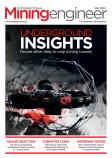For maximum production in narrow workings the load-and-haul function requires the maximum space to be used. Maurice Jones reports.
Despite a background trend for profitable extraction from low-grade, high-volume deposits, the mining of small-dimension mineralisation, such as veins, has retained an important place in the industry. Its importance increased with the increased price of gold and some other commodities and, despite recent ‘normalisation’, it retains this position. It is attractive to junior miners and countries with minimal infrastructure due to lower necessary capitalisation and less waste produced.
Against this past mining practices have associated narrow mining with some of the worst working conditions and safety record. However, with careful planning of the whole mining method including mechanisation, excavations for narrow vein exploitation or development can be carried out with maximum possible safety.
For maximum production in narrow workings the load-and-haul function requires the maximum space to be used. Of course space must be left for operators and access, and even so safety procedures have to be recognised by all concerned. These include provision of necessary ventilation, especially in blind ends, the use of low-emission diesel or electric prime movers, supply of sufficient fresh air, and setting a maximum number of workers in each ‘end’.
Blast design should also include consideration of the best fragmentation for load and transportation, the lowest harmful fumes possible, and the creation of a neat pile of rock for quicker loading.
Major manufacturers are usually more than willing to be included in feasibility discussions in selecting the right overall mining method covering such matters as the maximum haul distance in a narrow drive without by-passes for more than one vehicle for example; also whether ‘continuous’ loaders or load-haul-dump (LHDs) would be preferable. Trucks offer more flexibility, shorter and cheaper mobilisation, fitting in with trends to mining smaller deposits over shorter life spans.
The first key mechanised loaders used in narrow drives were ‘over the top’ rocker-shovels, made famous by Eimco, and the gathering-arm Joy loader. The latter, still available in an upgraded form, has the key design of a through-the-unit chain conveyor to pass the spoil to another conveyor or truck to the rear.
Continuous transport by conveyors can mean belt conveyors or ‘armoured’ chain conveyors. Depending on the mined section, belt conveyors may be mounted near the roof of the drive, leaving the floor clear for the passage of miners and supplies. The mass and power requirements of more robust chain conveyors tends to limit their length and siting options, but there are few, if any, alignment problems.
The GIA range, recently taken over by Atlas Copco, include Häggloaders and HäggCon shuttlecars, well know in narrow drives in civils tunnelling such as for water transfer. Recent sales have been made for development drives in South African gold mines. The 7HR wheel loader is a compact Häggloader design for drives as narrow as 2.5m and the same height, with a capacity of 2.5 m3/min. It is electrically powered, has tyred wheel, and can use either digging arms or a rotating backhoe to load its own conveyor, thence transferring into a dump truck or main conveyor. The backhoe can be swapped for an impact breaker for scaling.
The Paus PMKT dumpers are specially designed for transport in narrow drives. Both dumper and push-wall designs are available. A quick-change rigid hydraulic frame facilitates swapping on load modules, and two driver positions with 180-degree seat rotation aids safety and convenience in narrow-drive operation.
Video 1: A different approach to narrow vein mining developed by the Australian firm Mangala using boxhole boring to form a slot as designed and manufactured by Herrenknecht





















